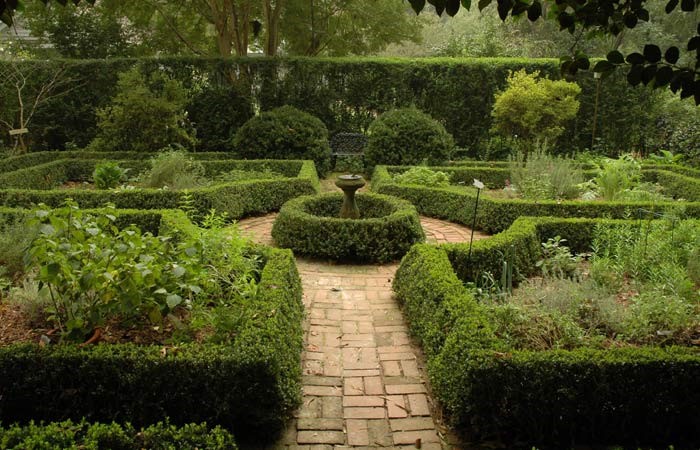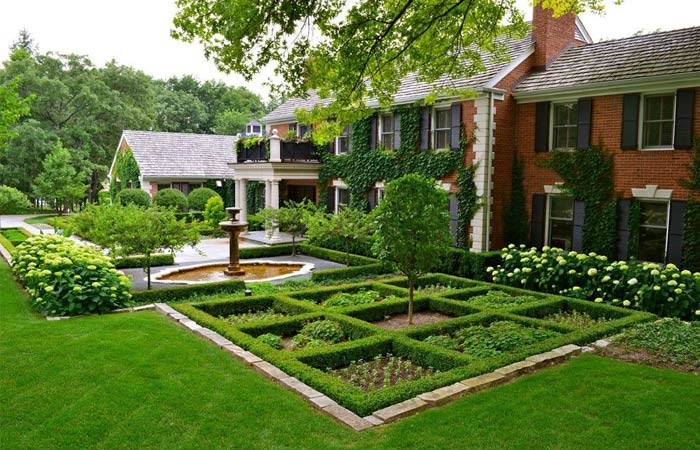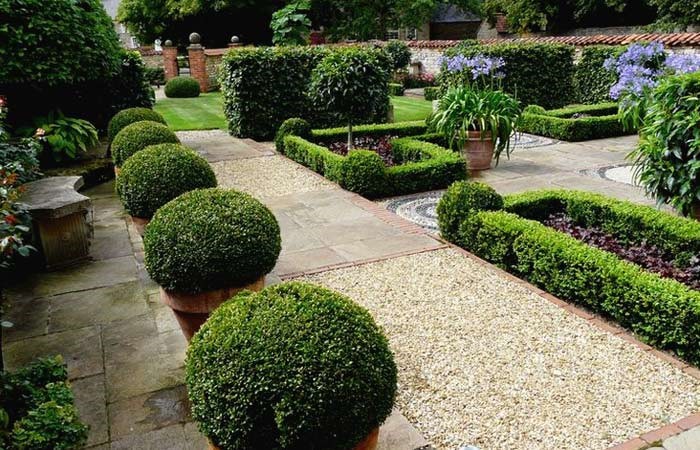Formal Garden Design Principles & Ideas

A formal garden design offers balanced, symmetrical, and geometrical shapes. The formal garden design style is as old as ancient Egypt, later spreading to Asia and Europe. In the formal garden design plans, walls, paths, or terracing form the structure of the garden. These elements control the plants as well. In this article, we are going to talk about these important elements of formal garden design and suitable plants for such gardens.
What Is Formal Garden Design?
The formal garden design seeks to indicate the power of the garden over nature. If you pay attention, you will see that in large or small formal garden design, plants only grow where planted in a pre-decided shape by the gardener.
Unlike the informal garden design, the formal approach has strict defined proportions and scale of architecture. These formal garden design principles were mirrored by the symmetrical design of the gardens.
Historically speaking, the formal garden design style was chosen to imply a sense of control over nature. But over time, almost every formal garden example became an intentional expression of wealth. Why? Because maintaining types of formal garden requires regular, difficult, and expensive labor work.
Types of Formal Garden
Typically, a modern formal garden design is inspired from European classical gardens by the 17th and 18th centuries. These gardens in Europe were also inspired by ancient Greece and Rome gardens.
As we mentioned, formal garden design ideas come from Oriental gardens from more than 3,000 years ago. Unlike European gardens, the Oriental formal garden design style may or may not have a strong structure. Oriental gardens engage Mother Nature by selecting parts of nature and reproducing it in a basic form. The result is a harmonious environment that is more reflective in nature.
Formal Garden Example
Perhaps nothing like the royal kingdoms can remind us of formal garden design plans. They had all the resources that they needed to build and maintain formal garden design ideas, including the fund and the man-power.
French formal garden design, or Jardin à la Française, is another famous example. This design follows a formal and ordered style with straight lines and symmetry. Like other gardens in this style, French formal garden design doesn’t fail to impress us too.
The French or royal kingdoms and their formal gardens may not be very common these days, but that doesn’t mean that we can’t enjoy a modern formal garden design or a semi-formal garden design. In the following part, we will tell you how to incorporate the same symmetrical principles into a small formal garden design.

Informal Garden Design
Obviously, an informal garden design has fewer rules. In addition, you don’t have to maintain it all the time. In the informal design, you’ll notice the attempt for duplicating Mother Nature while managing its chaos. The informal garden design can also replicate natural elements in a less random style by planting each plant in a specific location.
The informal garden design has less structure and more free-flowing. They can also have themes like specific color gardens, rose gardens, hosta gardens, or even fairy gardens.
Formal Garden Design Principles
No matter how big or small is your space, to have a true formal garden, you need to know and follow its principles. Still, one can bend or break these principles to create his or her own semi-formal or informal garden design.
1. The Right Architectural Layout
The most important factor that makes a formal garden distinctive and unique, is the layout and geometry of the space. It is fundamental to its success. Its layout emphasizes straight lines, angles, and circles with balanced proportions. This balance and symmetry offer a sense of order and calm. And as it is evident, this layout can survive fashion changes very well.
2. Repetition
Among formal garden design principles, repetition creates harmony as well as order. Thoughtfully repeating the same lines and spaces is very formal and classical. This principle complement structure and cohesion, and by making dimensions, the viewer thinks that the garden is larger than it really is.
3. Restraint
Restraint is a golden principle, even in small formal garden design ideas. If you want to design a formal garden that is successful, restraint is vital, whether it is the layout, the cold or warm color palette, or the planting, ornamental features, or anything else you want to include. Mass planting with fewer species but more of them help the harmony better. That’s why experts recommend us to avoid too many objects of interest and not over complicate a design.
4. Selecting Classic Plants
Plants play a key role in any garden. The formal garden design style includes signature symmetrical plants such as hedges. While they highlight the formal garden structure, to give the design a more classical touch, layering Murraya and Buxus is an excellent choice.
5. Ornamental Features
Have you looked at some of the formal garden design images? Most of them have included ornamental features as a focal point or to frame the view, right? This is another principle of designing a formal garden. Water features, statues, and urns are common choices as ornamental features. When picking features, experts recommend choosing slightly over scale instead of under scale.

Small Formal Garden Design Ideas
That’s right. You don’t need acres of land, several laborers, and a significant fund to have your own formal garden. Among formal garden design ideas, your easiest option is using symmetrical plantings.
For example, you can create a central line through your garden, and arrange the greenery (we’ll tell you what plants) on each side of that line in a symmetrical manner. Remember that most of the time, the formal garden design plans typically draw this central line from the house. So be sure to somehow relate this axis to your home.
This central line is the main path in your garden, and other paths are derived from it. This central axis is a reference point to develop all of the elements of formal garden design which we’ll introduce in the next parts.
For a true formal garden, you should feature your small formal garden design with geometric shapes and right angles (curves work fine too). To have a true formal garden example, you need to create well-defined and recognizable shapes. It is better that these shapes outline planting areas while being a part of the hardscape.

Elements of Formal Garden Design
Now that you know how to create a small formal garden design, let’s see what the elements of formal garden design are. After specifying the main axis and pathways, these are the signature element that you can add to your space:
- Focal Point: In the formal garden design plans, the focal point is either in the middle or at one end of the garden. The focal point can be an interesting statue or sculpture, a water feature, or a tree.
- Water Feature: Water feature actually isn’t necessary among elements of formal garden design, but it can complement your space. A large birdbath, a fountain, or a canal running through the axis are perfect water features for formal and even informal garden design.
- Vertical Interest: You can create vertical interest with topiaries, trees in a straight line, large urns, and stone or concrete pillars adorned with decorative planters. Just make sure not to use these features too much, and avoid clutter.
- Greenery: The established form for greenery in a large or a small formal garden design are clipped hedges, topiary, and lawns. This trimmed look is one of the important formal garden design principles. So take the time to mow the lawn and trim the hedges regularly. If you don’t have enough time, go for the bushes that have neat shapes in nature, like the low-maintenance xerophytes.
- Color: While considering formal garden design ideas, remember that unlike informal garden design, formal gardens have a limited color palette. So for the flowers, we recommend two or three harmonious colors at a time. Lay annual and perennial beds in geometrical shapes in the middle of lawns, or incorporate them as 1-foot-wide beds along the hedges. Be sure to plant them close to each other for a neat look. You can also o include a few trees as accents that offer seasonal color.

Formal Garden Plants
After formal garden design principles and elements, it is a good idea to know formal garden plants. The plants below can fit in your modern formal garden design perfectly.
Hedges and Topiary
Clipped hedges like yew, English holly, boxwood, rosemary, arborvitae, and privet, complete the structure of formal garden design style. They serve as boundaries for borders and offer the possibility of architectural topiary. We recommend evergreen and slow-growing ones for simpler maintenance.
Bushes
Bushes go with any formal garden design ideas as well. If you want to include bushes, we suggest considering Thuja, ficus, Brunfelsia, junipers, and pencil cypress.
Trees
We mentioned that trees can be a striking focal point. However, you can combine them with other vegetation. Trees like cherry, dogwood, crabapple, and fan palms are frequent in formal garden design images. They bring a sense of rhythm and order to gardens when they are used to flank walkways.
Flowers
For flowers, you can choose annuals or perennials. Among annuals, we recommend Marigolds, salvias, calendulas, tulips, begonias, and asters. If you prefer perennials, nepeta, lavender, hydrangea, echinacea, and daffodils are our favorite.
Other Plants
It is a smart idea to include plants that need minimal care in any design, formal or informal garden design. Agave, cycads, yucca, and date palms are striking and low-maintenance plants that you can include in your design.
It seems that you have all the information you need to design the formal garden of your dreams and enjoy it. Happy formal gardening!
- In this post:
- What Is Formal Garden Design?
- Informal Garden Design
- Formal Garden Design Principles
- Small Formal Garden Design Ideas
- Elements of Formal Garden Design
- Formal Garden Plants



